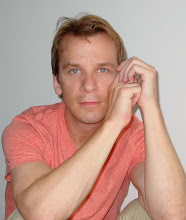The Hollywood Fringe Festival seemed to me to be an opportunity; an artist-participatory experience, and as such, after a year-long of following their e-mail blasts, and reading through their web-site of info, etc., I thought maybe this might be a place to explore the continuation of what began with my CalArts 2022 Artist Residency, namely the performance piece I created: Hauntology of the Infra Thin.
I am not sure what I want to say about this experience: one has only 15 minutes to set-up for their performance, and then 15 minutes to take it all down and leave the space open and clean for the following artists, and navigating this one detail; a detail that had the potential (knowing experientially after my 35+ years experience in the professional theatre (Broadway and all that) to override one's ability to actually PERFORM after this brutal set-up situation, I nonetheless pressed on, telling myself that, "whatever happens or is, will be a part of my experience and I will not allow anything from that specific to interfere with the work I need to do onstage, and if such an unexpected ensues, then I will absolutely know how to use it in a positive form for the work." Without my fabulous friend Marisa Ward - who has toured with everyone from Aerosmith to Stevie Nicks and more, and my daughter helping as "roadies," this set up would not have happened.
It isn't easy to call an audience to fill the theatre, even as small as it is - some 42 potential sold-out seats if I remember the number accurately - and even though I have worked for the most prominent professional theatre Group in Los Angeles for over 16 years, not one person from this institution came to see what I was up to. And one wonders, "if they are in the business of FINDING artists and their works to have, so they can be the producing institution they claim to be, it is a small wonder why they have not had the kind of early successes they previously enjoyed, for these last 20 or so years...bordering on shuttering their doors season after season, and resorting to begging audiences with a pre-curtain speech each night to, 'please support the arts.'"
Of course, my circle of friends I work with came and supported me, and some friends and family flying in, and that kind of support is invaluable. Being an artist who finds they are continually working in some kind of small bubble has its ups and lots of downs. Why and I doing this? Who is it for? Where am I going to put all this work...paintings, paintings, paintings, etc.?
My show The Infra Thin was concerning the enormous potential that rests waiting to be called into reality and shared. The work of the artist. Something I have been doing my entire life and am an absolute authority on. What I don't have the authority on is how to further get it out into the world. How do some people do this? What is the secret?
The previous summer I was with two friends, and after having just finished my year long Artist Residency one of them asked me in an accusing manner, "why aren't you selling your work? What is the problem? I have a friend in Minneapolis, and he does it, why can't you?" As if I have not done enough, have not tried my utmost. As if somehow I was dog-eared and sitting it out when I should be doing something more. Exactly what, I have no idea, but more, somehow. I have to say this comment has plagued me, the accusation that I have been lazy in any way is bewildering beyond just hurtful, because all I have worked toward, continuously, is sharing my work, getting it "out there" aiming for a kind of success so that it can simply be self-sustaining. That's it. I have not experienced that kind of success and so yeah, it hurts. But I don't need it pointed out to me. Trust me, I fucking know. Oh, and PS by the way, I just finished a "Year Long Artist Residency," producing some 50 paintings, and a 90 minute performance...that no one from the Institute that generated the Grant - CalArts - even bothered to come to...so yeah I should be selling paintings, lots and lots of them, but I'm not. Not for lack of trying, believe me.
At any rate, I was really happy with the work I produced, my show The Infra Thin. And I am continually searching for, and being open to, what might be the next stage of development for this piece, as I believe it is worthy of more and should be experienced. I don't think I will participate again in the Hollywood Fringe Festival. Been there, done that, and while I can't quite put my finger on the issue with it that it clearly contains, there is something about the HFF that is completely self-promoting for the Festival itself...and not for the enormous contributing component parts that actually make up what is the Festival, namely the artists. I felt and experienced myself out and alone in a kind of left-field creating, promoting, producing, and performing my show, and that the Festival was not contributing or supporting or even experiencing what I created in any way. I am sure I am not the only artist-performer who felt this. That being stated, I am not sure what it is I expected from or with the HFF, but anything other than nothing would have been something.












